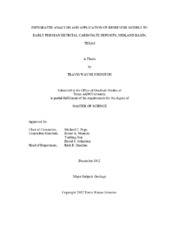| dc.description.abstract | A 3-D seismic volume, wireline logs and core data were integrated to determine the spatial distribution of porous reservoirs within the Wolfcampian-Leonardian detrital carbonate slope and basin strata in Glasscock County, Texas. A 3-D seismic amplitude volume was used to construct a seismic facies analysis of the detrital carbonate section, and generated attribute volumes helped identify detrital carbonate depositional trends, as well as establish a potential correlation between thick detrital carbonate intervals and associated amplitude response.
Eight lithofacies were identified in core and were subsequently classified into three main facies: debris flow, grain flow/turbidite, and basinal shale. A facies type log was then created, which was used to supervise the creation of facies logs within other wells to ultimately use in the creation of a 3-D facies model. Cross sections through the study area show an increase in bathymetric relief beginning in Wolfcampian time and continuing through the Leonardian. Detrital carbonate deposition increases dramatically during the Leonardian, consisting of large gravity flows deposited basinward in a northwest-southeast linear trend, rapidly thinning basinward. Individual flows are discontinuous and bounded by basinal shale facies.
Four seismic facies were identified within the interval of interest using a structurally smoothed attribute volume, while an RMS amplitude attribute volume provided a correlation between high RMS amplitude values and detrital carbonate thickness. A high RMS amplitude value corresponding to the debris flow facies was extracted from the RMS attribute volume in the form of a seismic geobody.
Two facies models and one porosity model were generated by using upscaled values from the gamma ray, total porosity, and lithofacies logs, which were applied over areas with the densest well control. Although the facies model populated from upscaled GR values was useful in stratigraphic interpretation, it is determined that the models should be applied over areas with denser well spacing in order to provide a more accurate and geologically viable subsurface model. | en |


